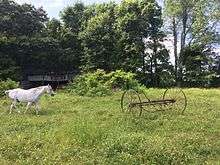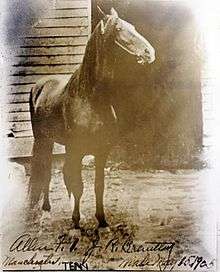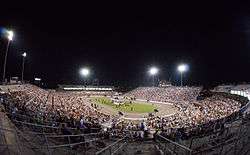Horse industry in Tennessee

The horse industry in Tennessee is the 6th largest in the United States, and over three million acres of Tennessee farmland are used for horse raising or horse-related activities. The most popular breed in the state is the eponymous Tennessee Walking Horse, and it became an official state symbol in 2000.
History and importance

Because Tennessee was largely rural in its early statehood, horses were important as a form of transportation. During the antebellum period, horse racing became a popular sport among the gentry.[1] After the Civil War, most of the native southern stock was gone, and horse breeding in Tennessee had to be continued with horses from Northern states.[1] Following the outlawing of betting in 1905, horse racing in Tennessee took a sharp drop and gaited horses began to rise in popularity. Commonly referred to as "Plantation" horses, they had been bred for a smooth gait that made riding over large distances easier. As farms became motorized and horses were replaced by tractors, interest in horse shows rose. This led to the specialized breeding of gaited horses for saddle seat show competition,[1] specifically the Tennessee Walking Horse. American Saddlebreds were also popular in the state during the 1930s and 1940s,[1] but dropped in popularity as the Tennessee Walking Horse came to the forefront of the state's horse shows.[2]
Today, Tennessee is ranked 6th on the list of US states by number of horses, and 3.2 million of its 10 million acres of farmland are used for horses or horse-related activity in some form. The Tennessee Walking Horse is the most popular breed in the state.[3]
Tennessee Walking Horse

The Tennessee Walking Horse, the first horse breed to be named for an American state,[4] was developed in the Middle Basin of Tennessee. Horse breeder James Brantley began his breeding program in the early 1900s using the foundation stallion Black Allan,[5] who had a smooth running walk and a calm disposition which he passed on to his offspring.[6] Though Black Allan died in 1910, shortly after being sold to another breeder named Albert Dement, he sired 40 known foals whose bloodline became well known in the region.[7] One of his sons, Roan Allen, carried on his bloodline and is estimated by horse breeding experts to be the ancestor of 100% of living Tennessee Walking Horses.[8]
Brantley's and Dement's farms were both located just outside Wartrace, and the town is known as "The cradle of the Tennessee Walking Horse".[9] The breed's main registry, the Tennessee Walking Horse Breeders' and Exhibitors' Association (TWHBEA), was founded in 1935 in Lewisburg and is still located downtown.[10] In 1939 Henry Davis and a group of fellow horsemen held the inaugural Tennessee Walking Horse National Celebration;[5][5] it lasted three days and ended with Strolling Jim, trained by Floyd Carothers, being crowned as the first World Grand Champion.[11] After the founding of the TWHBEA and then Celebration, the Walking Horse jumped in popularity and many notable breeding farms were established, including Harlinsdale Farm, and horse trainers began to focus on training Tennessee Walkers specifically for show competition. Trainers who became notable during this period include Winston Wiser, Fred Walker and Steve Hill.[1]
Today the Tennessee Walking Horse continues to be highly important to the Middle Basin. The town of Shelbyville is called the Tennessee Walking Horse Capital of the World,[12] and has hosted the Celebration for most of its history; the first few Celebrations were held in Wartrace, but the move was made due to space issues.[13] The Tennessee Walking Horse National Museum was founded in the 1980s and was hosted in several locations[14] before moving to its permanent location in Wartrace.[15] The Middle Basin is home to many farms and training stables which specialize in the breed,[4] with Bedford, Rutherford, Coffee and Cannon counties having the largest populations.[16] The breed also brings in large amounts of revenue to the state; the Celebration annually generates $41 million in income to Shelbyville alone, and individual horses can sell in excess of $100,000.[17]
There are multiple institutions and landmarks in the area named after the Walking Horse, including the Walking Horse and Eastern Railroad, which runs between Shelbyville and Wartrace, and the Walking Horse Hotel in Wartrace, which was the home of Strolling Jim.[18] [15]
The Tennessee Walking Horse was officially named the state horse by the General Assembly of Tennessee in 2000.[19]
Notable farms and stables
- Ailshie Stables, Greeneville, a Racking Horse stable run by three generations of the Ailshie family. The founder, Kenny Ailshie, won six World Grand Championships in the Racking Horse World Celebration, in 1987, 1991, 1992, 1998, 2002, and 2006. His son Keith won the World Grand Championship in 2001. Grandson Brandon won it in 2017.[20][21]
- Ashcrest Farm, Hendersonville, a historic plantation on the National Register of Historic Places. It now serves as a horse boarding facility.[22]
- Belle Meade Plantation, Belle Meade, a former Thoroughbred racehorse breeding farm that produced Iroquois, the first American horse to win England's Epsom Derby.[1]
- Bobo Farms, Shelbyville, a Tennessee Walking Horse training facility that showed the 2003 World Grand Champion, The Whole Nine Yards.[2]
- Brantley Farm, Wartrace, the earliest Tennessee Walking Horse breeding farm.
- Clearview Farm, an all-breed boarding facility that also hosts horse shows.[23]
- Dickie Gardner Stables, Shelbyville, a Spotted Saddle Horse stable that has produced multiple World Champions.[24]
- Harlinsdale Farm, Franklin, a Tennessee Walking Horse breeding farm that became notable as the home of 1945-1946 World Grand Champion show horse and sire Midnight Sun. Harlinsdale also bred Dark Spirit's Rebel, 1992 World Grand Champion,[25][26] in addition to Rowdy Rev and several dozen other champions.[2]
- Joe and Judy Martin Stables, Shelbyville, a Tennessee Walking Horse stable that trained the World Grand Champion Shades of Carbon.[27]
- Milky Way Farm, Pulaski, a former Thoroughbred breeding farm that bred and owned the 1940 Kentucky Derby winner, Gallahadion. Milky Way was the leading Thoroughbred owner in America for the 1940 racing season.[28]
- Solitude Stock Farm, Goodlettsville, which bred World Grand Champion and notable Tennessee Walking Horse sire Ebony Masterpiece.[29]
- Waterfall Farms, Shelbyville, a Tennessee Walking Horse breeding farm. It stood World Grand Champion He's Puttin' on the Ritz at stud.[30]
Horse shows and rodeos

Many horse shows in Tennessee are oriented around the state's namesake breed, the Tennessee Walking Horse. The largest of these is the Tennessee Walking Horse National Celebration, an 11-day competition that takes place on the 105-acre Celebration Grounds in Shelbyville just before Labor Day every year. The Celebration attracts over 1,500 horses and 200,000 spectators.[5] The Spring Celebration, also known as the Spring Fun Show, is another Tennessee Walking Horse show that traditionally is important for horses and trainers hoping to compete in the main Celebration later in the year. It is held on the Celebration Grounds and dates back to 1970.[31] The National Trainers Show is held annually by the Walking Horse Trainers' Association. It is almost always held in Shelbyville, although it has been held in Alabama twice, in 1988 and 2015.[32] Besides the larger shows that last multiple days, Tennessee also hosts a number of significant one-day Tennessee Walking Horse shows. The Wartrace Horse Show is the oldest one-night horse show in Tennessee, and has been held annually since 1906.[33]
Tennessee is also known for breeding mules, and a mule show called Mule Day has been held in Maury County for 170 years.[3] The Calsonic Arena in Shelbyville hosts the Great Celebration Mule Show each July.[34]
Tennessee also hosts a number of horse shows for breeds that predated or derived from the Tennessee Walking Horse. The Spotted Saddle Horse is a pinto-patterned breed that was developed using large amounts of Tennessee Walking Horse blood. Two major shows for it are held at the Celebration Grounds every year; the Spring Show in May and World Championship in September.[24][35] The Spotted Saddle Horse's biggest registry, the Spotted Saddle Horse Breeders' and Exhibitors' Association, is located in Shelbyville.[36]
For several decades, the World Championship for the American Saddlebred was held at the Music City Horse Show in Nashville. Although it has been moved to Lexington, Kentucky,[37] Tennessee still hosts some Saddlebred shows and sales.[37]
Tennessee also hosts rodeos and non-traditional events beside traditional horse shows. The Lone Star Rodeo has been held at Calsonic Arena for more than 25 years. It features all traditional rodeo events.[38] In 2016, the group that owns Lone Star Rodeo held their first youth rodeo in Tennessee. It awarded more thsn $70,000 in prize money and featured specialized events such as pony bronc riding.[39]
Road to the Horse, a colt-starting competition for professional trainers, was held at Murfreesboro's Tennessee Miller Coliseum from 2002 to 2011.[40]
Horse racing
Horse racing was a popular form of recreation in colonial and antebellum Tennessee. Most early races were held on public roads, including a notable match in 1806 between Andrew Jackson's horse Truxton and Erwin's Plowboy. Truxton, who won the race, was a son of Diomed, a Thoroughbred imported from England.[41] In 1836 a horse breeder said, "The prevailing opinion in the South is that Tennessee possesses more and better racehorses than Kentucky."[41] The Standardbred Little Brown Jug, who had a premier pacing race named after him, was foaled in Middle Tennessee. Standardbred racing was very popular in late nineteenth-century Tennessee.[42]
Tennessee continued to host many notable racing stables throughout the post-Civil War years,[1] until Tennessee passed an anti-gambling law in 1905, which essentially outlawed betting at racetracks. This led to a steep drop in the number of horse races and racehorses, and a loss of interest in the sport.[43] The passage of the law also ended the Tennessee Derby, which had been held since 1884 and at one time rivalled the Kentucky Derby for prestige. [44]
However, horse racing itself is not illegal, and small races are still held in Tennessee, including harness races at the Lincoln County Fair every year.[45] There have been multiple attempts to legalize betting in Tennessee again, but most have eventually failed. In 2016 Republican state senator Frank Niceley sponsored a bill that would have legalized betting at racetracks, but it failed in the State House of Representatives. However, the Horse Racing Advisory Committee was formed in order to promote horse racing in the state.[45] One of the largest horse races in Tennessee is the Iroquois Steeplechase, a steeplechase held in Nashville's Percy Warner Park. It was founded in 1941 and is held annually on the second Saturday in May, along with 6 other races. Attendance routinely averages 30,000.[46]
Trail riding
There are three horseback riding concessions located near Gatlinburg, Tennessee, which allow visitors to rent horses and ride them through Great Smoky Mountains National Park, including Cades Cove.[47]
Visitors may also bring their own horses to ride in the park, but a negative Coggins test is required.[47]
The smaller Lebanon State Park also allows visitors to bring their own horses and ride through the park, but there is no rental stable.[48][49]
References
- 1 2 3 4 5 6 7 Beisel, Perky; Dehart, Rob (1 January 2007). "Middle Tennessee Horse Breeding". Arcadia Publishing. Retrieved 10 December 2016 – via Google Books.
- 1 2 3 http://www.twhbea.com/voice/Features/BillHarlin.htm
- 1 2 Flavor, Farm. "Tennessee Equine Facts and Stats - Farm Flavor". Retrieved 10 December 2016.
- 1 2 Littman, Margaret (21 June 2016). "Moon Tennessee". Avalon Travel. Retrieved 10 December 2016 – via Google Books.
- 1 2 3 4 Schultz, Patricia (11 March 2011). "1,000 Places to See in the United States and Canada Before You Die". Workman Publishing. Retrieved 10 December 2016 – via Google Books.
- ↑ Ward, Kathleen Rauschl (1 January 1991). "The American Horse: From Conquistadors to the Twenty-First Century". Maple Yard Publications. Retrieved 10 December 2016 – via Google Books.
- ↑ "Westwood Farms Reference: Allan". Retrieved 10 December 2016.
- ↑ "Tennessee Walking Horse - Roan Allen F-38 Homepage". Retrieved 13 December 2016.
- ↑ Green, Ben A. (1 January 1960). "Biography of the Tennessee walking horse". Parthenon Press. Retrieved 10 December 2016 – via Google Books.
- ↑ Harris, Moira C.; Langrish, Bob (1 January 2003). "America's Horses: A Celebration of the Horse Breeds Born in the U. S. A." Globe Pequot Press. Retrieved 10 December 2016 – via Google Books.
- ↑ Beisel, Perky; Dehart, Rob (1 January 2007). "Middle Tennessee Horse Breeding". Arcadia Publishing. Retrieved 10 December 2016 – via Google Books.
- ↑ "shelbyvilletn.org". Retrieved 10 December 2016.
- ↑ Summerlin, Cathy; Summerlin, Vernon (30 January 1999). "Traveling Tennessee: A Complete Tour Guide to the Volunteer State from the Highlands of the Smoky Mountains to the Banks of the Mississippi River". Thomas Nelson Inc. Retrieved 10 December 2016 – via Google Books.
- ↑ Littman, Margaret (23 July 2013). "Moon Tennessee". Avalon Travel. Retrieved 10 December 2016 – via Google Books.
- 1 2 Schultz, Patricia (29 November 2016). "1,000 Places to See in the United States and Canada Before You Die". Workman Publishing. Retrieved 10 December 2016 – via Google Books.
- ↑ Beisel, Perky; Dehart, Rob (1 January 2007). "Middle Tennessee Horse Breeding". Arcadia Publishing. Retrieved 10 December 2016 – via Google Books.
- ↑ "Times Daily - Google News Archive Search". Retrieved 13 December 2016.
- ↑ Summerlin, Cathy; Summerlin, Vernon (30 January 1999). "Traveling Tennessee: A Complete Tour Guide to the Volunteer State from the Highlands of the Smoky Mountains to the Banks of the Mississippi River". Thomas Nelson Inc. Retrieved 10 December 2016 – via Google Books.
- ↑ McClellan, Adam (1 January 2004). "Uniquely Tennessee". Heinemann-Raintree Library. Retrieved 10 December 2016 – via Google Books.
- ↑ https://www.greenevillesun.com/sports/greeneville-s-ailshie-stables-dominates-world-class-racking-horse-business/article_7cd05f8a-778d-5168-bf16-2a00e910b147.html
- ↑ https://www.walkinghorsereport.com/news/Young-trainer-racks-to-the-roses
- ↑ "For century farm owners, blood runs deep". Retrieved 13 December 2016.
- ↑ "Big donkey, mule show is this week". Retrieved 10 December 2016.
- 1 2 "Gardner is a familar face in SSHBEA". Retrieved 10 December 2016.
- ↑ Littman, Margaret (21 June 2016). "Moon Tennessee". Avalon Travel. Retrieved 10 December 2016 – via Google Books.
- ↑ "Times Daily - Google News Archive Search". Retrieved 13 December 2016.
- ↑ https://news.google.com/newspapers?nid=1891&dat=19760906&id=W0snAAAAIBAJ&sjid=K9YEAAAAIBAJ&pg=2303,993839&hl=en
- ↑ "1940 - 2017 Kentucky Derby & Oaks - May 5 and 6, 2017 - Tickets, Events, News". Retrieved 10 December 2016.
- ↑ "Ebony Masterpiece #560586 home page by Walkers West". Retrieved 13 December 2016.
- ↑ http://www.t-g.com/story/2327455.html
- ↑ "Untitled Document". Archived from the original on 18 September 2016. Retrieved 10 December 2016.
- ↑ Writer, Leah Cayson Staff. "Controversy follows Walking Horse Trainers Show to Morgan County". Retrieved 10 December 2016.
- ↑ "100 Years Of Walking In Wartrace". Archived from the original on 4 March 2016. Retrieved 10 December 2016.
- ↑ Mischka, Robert A. (1 January 1994). "Let's Show Your Mule". Mischka Press/Heart Prairie. Retrieved 10 December 2016 – via Google Books.
- ↑ "SSHBEA hosts spring show". Retrieved 10 December 2016.
- ↑ Swartout, Kristy A.; (Firm), Cengage Learning (1 April 2008). "Encyclopedia of Associations V1 National Org 46". Gale/Cengage. Retrieved 10 December 2016 – via Google Books.
- 1 2 "New equestrian event comes to middle Tennessee". Retrieved 10 December 2016.
- ↑ "Back in the saddle: Lone Star Rodeo plans local stop". Retrieved 10 December 2016.
- ↑ "Huge youth rodeo coming to Shelbyville". Retrieved 10 December 2016.
- ↑ "History". 2 December 2014. Retrieved 10 December 2016.
- 1 2 Beisel, Perky; DeHart, Rob (10 October 2007). "Middle Tennessee Horse Breeding". Arcadia Publishing. Retrieved 10 December 2016 – via Google Books.
- ↑ Beisel, Perky; Dehart, Rob (1 January 2007). "Middle Tennessee Horse Breeding". Arcadia Publishing. Retrieved 10 December 2016 – via Google Books.
- ↑ "Tennessee Historical Quarterly". Tennessee Historical Society. 1 January 2008. Retrieved 10 December 2016 – via Google Books.
- ↑ https://query.nytimes.com/gst/abstract.html?res=9F03E0D61E3AE733A25756C0A9629C946597D6CF&legacy=true
- 1 2 "Will horse racing — and betting — make a comeback in Tennessee?". Retrieved 10 December 2016.
- ↑ "Nashville". Rowman & Littlefield. Retrieved 10 December 2016 – via Google Books.
- 1 2 Michael Ream, Dan Sluder (7 April 2009). Salwa Jabado, ed. "Great Smoky Mountains National Park". Fodor's Travel Publications. p. 60. Retrieved 10 December 2016 – via Google Books.
- ↑ Summerlin, Cathy; Summerlin, Vernon (30 January 1999). "Traveling Tennessee: A Complete Tour Guide to the Volunteer State from the Highlands of the Smoky Mountains to the Banks of the Mississippi River". Thomas Nelson Inc. p. 188. Retrieved 10 December 2016 – via Google Books.
- ↑ Thalimer, Carol; Thalimer, Dan (1 January 2002). "Romantic Tennessee". John F. Blair, Publisher. p. 101. Retrieved 10 December 2016 – via Google Books.